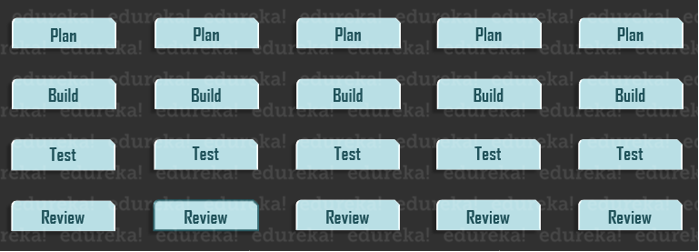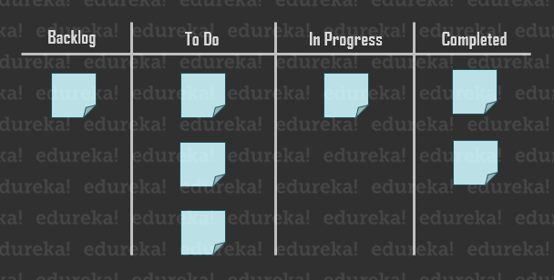PMP Certification Training
- 87k Enrolled Learners
- Weekend/Weekday
- Live Class
In the world of Project Management, especially software, two approaches are abuzz – Scrum and Kanban. Both being highly sought after Agile–based frameworks, ensure streamlined projects and increased efficiency. So, we thought of bringing you a little Scrum vs Kanban article.
Scrum is a framework which enables people to address complex adaptive problems. It aims to productively and creatively deliver products of the highest possible value through iterations and increments in a time-boxed setting.

Kanban is a workflow management method designed to help you maximise efficiency through continuous visualisation of your work. The word literally translates to “billboard”, in Japanese. Originating from manufacturing, it later made its way into agile software development teams.

Both Scrum and Kanban break down large and complex tasks to complete them efficiently. Both place extreme importance on continual improvement, optimization of the work and the process. And both share the very similar focus on a highly visible workflow that keeps all team members in the loop on the Work In Process.
As alluded to above, there are a number of differences in both the philosophies, when it comes to the practical application of Scrum and Kanban. While the individual differences are many, they’re based on either scheduling, iteration or cadence.
Scrum and Kanban, they both strive to increase quality along with productivity and bring efficiency in the organisation. However, there are a few key differences between them.

In Scrum, every member of the scrum team has a fixed job description and responsibilities that come with it such as, the Scrum Master, Product Owner, Team members or Stakeholders where every role has its fixed responsibilities and no one ideally should play more than one role at a time, despite the cross-functional teams.
Kanban does not have set roles and it portrays complete flexibility in terms of individual responsibilities. In the absence of roles, team members are assigned work according to their specialisation or preference.

Members of Scrum Teams are required to commit to a specific amount of work. To identify all the tasks, prioritise them and estimate the time-box for each task, along with the number of story-points that are assigned to it, are very important. A commitment should then be provided based on this estimation.
Commitment is an option and not a compulsion for teams following Kanban. Thus, these teams work at their natural speed. At times, they may deliver more while there will be other times when they may deliver less in the same time duration.

Since Scrum demands a certain level of commitment, any obstacles or challenges that arise need to be immediately dealt with. The team tries to commit as early as possible to retain its momentum and deliver on time.
The workflow and progress in Kanban are completely transparent and so the teams can spot obstacles and bottlenecks easily. They are thus, able to avoid such hurdles and ensure smooth flow of work.

In Scrum, cross-functional teams are necessary as they are able to deal with any disruption much better. Disruptions that may cause a bottleneck in the process. However, a cross-functional team doesn’t mean that everyone performs every task. It means to equip certain members of different teams with various other important skills.
Instead of cross-functional teams, Kanban encourages the use of specialised teams. Any team or all teams involved in the project can use the workflow, such is the intention of Kanban.

In Scrum, all the teams focus to collaborate and complete the tasks to produce something of greater value. Scrum encourages conducting daily scrums to educate every member of other’s responsibilities. The team works together and team members help each other to achieve their team goals.
In Kanban, teams strive to achieve goals and reduce the amount of time taken to complete the entire process. A reduction in the average time cycle is one of the reasons of success here.

Since Scrum places heavy emphasis on schedule, one cannot add new items to ongoing iterations. Only when the current sprint is completed can a scrum team take on another sprint. In time, teams get adept at estimating and scheduling sprints accordingly.
Kanban is more iterative in nature due to lack of time-frames. And so new items can be continuously added whenever additional capacity is available or when the project demands. When any task moves from the in-progress stage to the completed stage, a new task can be taken up immediately.

Only one team at a time owns the backlog, as Scrum encourages cross-functional teams. Each team has all the necessary skills to successfully complete any task during the sprint.
Kanban boards have no ownership. Multiple teams can share them as everyone has their own dedicated tasks.
Category | Scrum | Kanban |
Roles & Responsibilities | Every member of the scrum team has a fixed job description and responsibilities that come with it. | Kanban does not have set roles and it portrays complete flexibility in terms of individual responsibilities. |
Teams & Commitment | Members are required to commit to a specific amount of work. | Commitment is an option and not a compulsion for teams. |
Addressing Challenges | Any obstacles or challenges that arise need to be immediately dealt with. | Hurdles are avoided to ensure smooth flow of work. |
Types of Teams | Cross-functional teams are necessary for Scrum. | In Kanban, specialised teams are encouraged. |
Objective of the Team | Teams focus to collaborate and complete the tasks to produce something of greater value. | Teams strive to achieve goals and reduce the amount of time taken to complete the entire process. |
Iterations | One cannot add new items to ongoing iterations. | New items can be continuously added whenever additional capacity is available. |
Ownership | One team owns the backlog at a time. | Kanban boards have no ownership. |
Are you struggling to choose the best Agile framework for your team or organization? With so many options available, it can be overwhelming to decide which one is right for you. In this video, we’ll explore the most popular Agile frameworks, including Scrum and Kanban, and help you determine which one is the best fit for your specific needs and goals. Whether you’re a project manager, team lead, or developer, this video will provide you with a comprehensive overview of each framework, including their strengths, weaknesses, and use cases. By the end of this video, you’ll have a clear understanding of which Agile framework is best suited for your team and how to implement it effectively.
Many large companies have adopted either Scrum or Kanban for product development and project management.
Teams in companies like Apple, Google, Amazon are using Scrum whereas some like Pixar, Zara, Spotify have gone for Kanban.
It is clear that both Scrum and Kanban have their pros and cons.
Many Scrum teams use Kanban additionally, as a visual process and project management tool. Some teams prefer to use only Scrum because of its prescriptive nature and lesser ambiguity. But there are many, that have adopted select principles of Kanban that are useful in adding an extra layer of visibility to their projects.
When making a choice, an individual distinction doesn’t always have to be made between both frameworks because Kanban and Scrum work best hand-in-hand.
The Certified Scrum Master Training at Edureka provides a comprehensive overview of the Scrum framework for agile project management and will prepare you to become a certified Scrum Master. You’ll learn the fundamentals of Scrum such as the Scrum life cycle, how to organise a Scrum team and set up a project, and how to implement a Scrum, from releases and sprints to enterprise transformation. This two-day classroom training will open new career opportunities for you in multiple industry sectors.
 Thank you for registering Join Edureka Meetup community for 100+ Free Webinars each month JOIN MEETUP GROUP
Thank you for registering Join Edureka Meetup community for 100+ Free Webinars each month JOIN MEETUP GROUPedureka.co